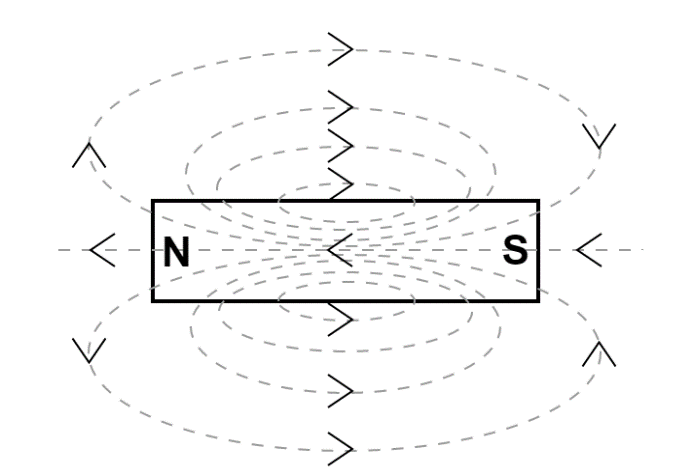
The magnetic lines of force inside a bar magnet:
(A) Are from north-pole to south-pole of the magnet
(B) Do not exist
(C) Depends upon the area of cross-section of the bar magnet
(D) Are from south-pole to north-pole of the magnet
Answer
176.1k+ views
Hint: - The magnetic forces around the area of a magnet is known as a magnetic field. In a bar magnet, the magnetic fields are durable at either pole of the magnet. It is also just as strong at the north-pole when compared with the south-pole. At the center of the magnet and in between the poles, the force is weaker.
Complete Step-by-step solution:
General properties of magnetic field lines:
(1) The magnetic lines of force always make closed loops.
(2) When going from an area of higher permeability to an area of lower permeability the field lines tend to bulge out i.e. when going from the surface of the magnet to the air density of the field line decreases.
(3) Every field line has the same strength.
(4) They never cross each other.
(5) By convention, these field lines seem to originate from the north pole & end into the south pole of a bar magnet.
(6) The direction inverses inside the magnet i.e. they appear to move from the south pole towards the north pole.

For that reason, the magnetic lines of forces inside a bar magnet are from south-pole to north-pole of the magnet.
Thus, the correct option is (D) Are from south-pole to north-pole of the magnet.
Additional Information: Magnetic lines of force are imaginary lines to indicate their magnetic field. It helps to understand the density of the magnetic field lines; hence magnetism will be easier to understand. Magnetic flux is the term used to define the number of lines of force passing through the unit area.
Note: The magnetic field lines are almost parallel to each other, as the bar magnet is made up of uniform ferromagnetic material with constant permeability throughout its length & bulge out as the lines move reverse to the poles & pass through air. Inside the bar magnet, the magnetic lines are ongoing their journey to the opposite end.
Complete Step-by-step solution:
General properties of magnetic field lines:
(1) The magnetic lines of force always make closed loops.
(2) When going from an area of higher permeability to an area of lower permeability the field lines tend to bulge out i.e. when going from the surface of the magnet to the air density of the field line decreases.
(3) Every field line has the same strength.
(4) They never cross each other.
(5) By convention, these field lines seem to originate from the north pole & end into the south pole of a bar magnet.
(6) The direction inverses inside the magnet i.e. they appear to move from the south pole towards the north pole.

For that reason, the magnetic lines of forces inside a bar magnet are from south-pole to north-pole of the magnet.
Thus, the correct option is (D) Are from south-pole to north-pole of the magnet.
Additional Information: Magnetic lines of force are imaginary lines to indicate their magnetic field. It helps to understand the density of the magnetic field lines; hence magnetism will be easier to understand. Magnetic flux is the term used to define the number of lines of force passing through the unit area.
Note: The magnetic field lines are almost parallel to each other, as the bar magnet is made up of uniform ferromagnetic material with constant permeability throughout its length & bulge out as the lines move reverse to the poles & pass through air. Inside the bar magnet, the magnetic lines are ongoing their journey to the opposite end.
Recently Updated Pages
JEE Main Physics Mock Test 2025

JEE Main Maths Mock Test 2025: FREE Online Mock Test Series

JEE Main Chemistry Mock Test 2025

JEE Main 2025-26 Atoms and Nuclei Mock Test: Free Practice Online

JEE Main 2025-26: Dual Nature of Matter and Radiation Mock Test

JEE Main 2025-26 Electronic Devices Mock Test – Free Practice

Trending doubts
JEE Main 2025 Session 2: Application Form (Out), Exam Dates (Released), Eligibility, & More

JEE Main 2025: Derivation of Equation of Trajectory in Physics

Displacement-Time Graph and Velocity-Time Graph for JEE

Uniform Acceleration

Electric field due to uniformly charged sphere class 12 physics JEE_Main

Atomic Structure - Electrons, Protons, Neutrons and Atomic Models

Other Pages
JEE Advanced Marks vs Ranks 2025: Understanding Category-wise Qualifying Marks and Previous Year Cut-offs

Learn About Angle Of Deviation In Prism: JEE Main Physics 2025

Degree of Dissociation and Its Formula With Solved Example for JEE

What is Hybridisation in Chemistry?

JEE Advanced Weightage 2025 Chapter-Wise for Physics, Maths and Chemistry

Essential Derivations for CBSE Class 12 Physics: Stepwise & PDF Solutions




